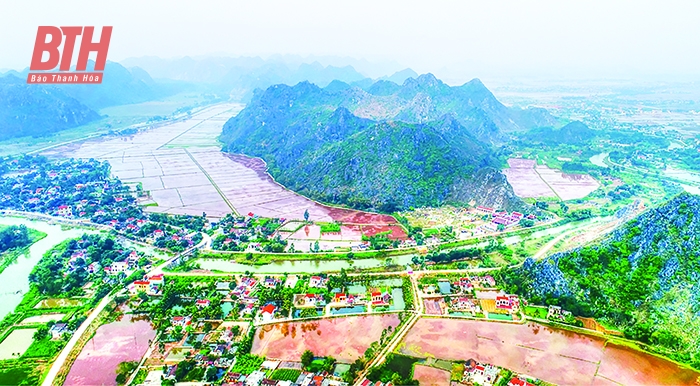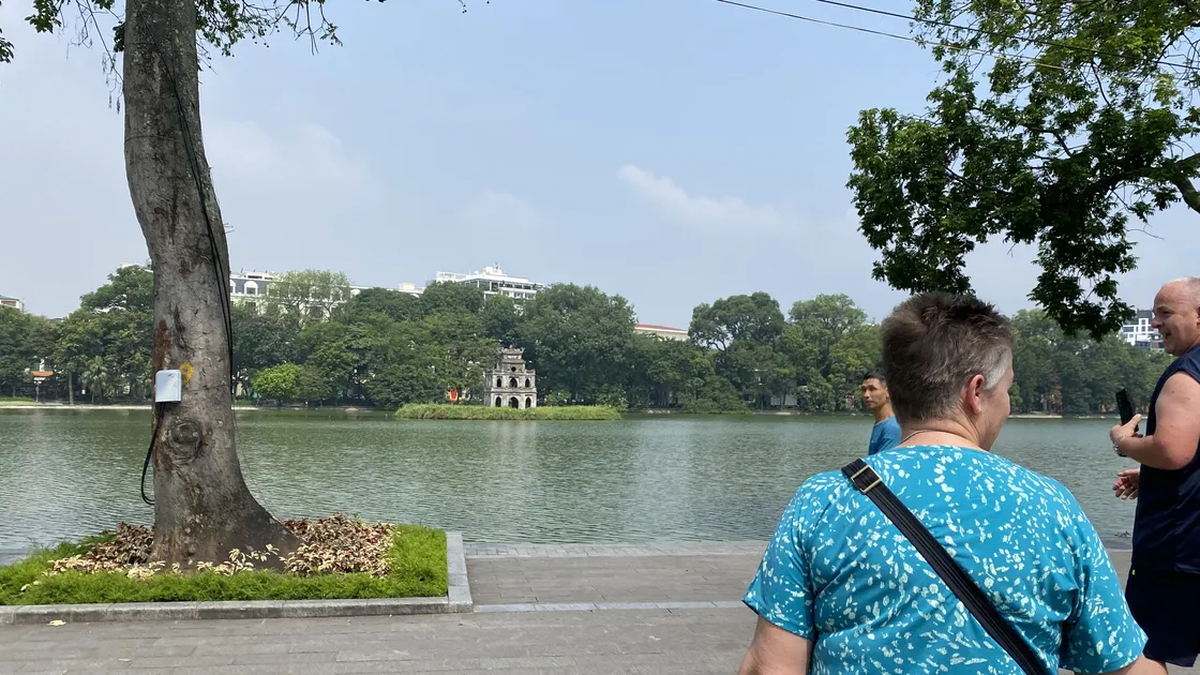The land of Nga Son often evokes nostalgia and memories of a beautiful natural landscape with mountains, rivers, green fields and a system of historical and cultural relics, imbued with many legends and myths... Just the Hoat Giang river alone, with its gentle flowing water for generations, is enough to weave a charming landscape painting, marking landmarks, relics, whispering stories of thousand-year-old love...
Beautiful scenery on both banks of Hoat River. Photo: document
Hoat River originates from Yen Thinh, Ha Trung at an altitude of 125m above sea level, gradually flows down to the estuary, stretches 55km, flows through 2 districts Ha Trung and Nga Son. From the area of Cu bridge up, it is often called Man Bao river, the area below Cu bridge is familiarly called Hoat river. At Nga Vinh entrance, Hoat river receives a branch from the North flowing to Tong river; from Tong river mouth to the sea, it is often called Can river. Can river flows in the West - East direction to Nga Dien, about 12km from the sea, then changes direction to North - South, almost perpendicular to the old direction, flows through two communes Nga Thai, Nga Thuy and out to sea at Can estuary. Beyond Cu bridge, Hoat river enters a low area, then weaves between a limestone mountain range about 5m long (accounting for 1/10 of the river length, belonging to 3 communes Nga Giap, Nga An, Nga Thien). Sketching here the journey of the Hoat River to see that: the river's life is always faithful and loyal to the land and people of Nga Son, together painting captivating landscapes, together weaving unique and typical historical and cultural layers.
Down the Hoat River, to the land of Nga Thien, where there is Tu Thuc cave and the famous love story of Tu Thuc - Giang Huong. Tu Thuc cave is also known by another beautiful name - Bich Dao cave, is a system of limestone caves located on the slope of a small rocky mountain, surrounded by endless green rice fields, about 200m long, thousands of square meters wide, the highest cave dome is about 40m, considered as "the most famous cave" of the South. Right from the entrance to the cave, the natural scenery makes people's hearts flutter with love and excitement. The shadows of ancient trees cover the sky, the roots of vines swing down on the concrete road of more than 100 steps leading to the cave, creating a feeling of wildness, seclusion, and mystery as if walking on the path to a fairyland. Many visitors cannot help but enjoy sitting on the tree roots, imagining that they are returning to the primitive, instinctive, and closest to nature. Right in front of the cave entrance, visitors will encounter two Chinese poems carved on stone praising the beauty of the cave, composed by talented people...
The point that makes Tu Thuc cave attractive and unique is the system of stalactites with myriad shapes and sparkling colors. Anyone who has ever been to Tu Thuc cave will surely be amazed and amazed by the ingenious and marvelous arrangement of nature that has created so many beautiful scenes that seem real, like a dream, shimmering with brilliant colors and myriad shapes. Tu Thuc cave is divided into 3 small caves: the outer cave, the middle cave and the inner cave, or commonly known as the three palaces. It seems that when we touch those stalactites, we will hear sounds from somewhere in the void, telling the love story of Tu Thuc and Giang Huong: Leaving the boat, inspired to visit Tu Cong / The cave door is still locked with a rosy light / The walls of the Siamese silk are hung with shimmering brocade / The phoenix sings, the stone knocks on the palace of love / The fairy fate has been promised since our three lives / How many times has the sea of suffering risen / Don't say that the days have passed by / Playing here is no different from a walk in Bong Lang (poem by Lord Trinh Sam, transcribed and translated by Hong Phi). Fairyland and earthly world, reality and fantasy intertwine in the story, proving that the romanticism, optimism, and love of life are the nature of the Vietnamese people. Did the love story of Tu Thuc - Giang Huong breathe life into the rocks and mountains? Or did the presence of the rocks and mountains affirm the vitality of that love story? There is no need to clearly distinguish, because the rocks, mountains, and that love story have blended together, lived in each other, and together sublimated and left their mark.
Bach A Cave with its wild and mysterious beauty.
A famous scenic spot of Nga Thien is the stele mountain, where in ancient times there was a rocky outcrop jutting out into the river where boats could pass under the mountain, on the mountain was carved the word "Than" in very large Chinese characters. What is special about Nga Son is the presence of many place names associated with the word Than (Than Phu gate, stele, well...). And the stele mountain on the journey downstream of the Hoat River has left a more mysterious mark, imbued with spiritual colors. Looking at the strong, liberal letters carved on the rock, in a rugged mountainous location, it seems to prove that this is a sacred land, protected and blessed by gods.
Also on this land of Nga Thien, besides the attraction of Tu Thuc cave, visitors can visit Bach A cave - a unique landscape, where many historical and cultural values are preserved. Bach A cave (also known as Bach Ac cave, Bach Nha cave, Bien Phuc Coc), located in the heart of a rocky mountain, has long been known as a place with amazing natural scenery. The ancients named the cave Bach A, meaning in Chinese characters "white crow" because from afar, looking towards the cave entrance, it looks like a giant crow spreading its wings in a vast sky filled with silver clouds. The soil in the cave is ivory white, surrounded by rivers and water, so the scenery around the cave seems to open up immensely. Bach A cave is also home to many bats. Therefore, from ancient times until now, local people also call the cave by another name, Bat Cave (Bien Phuc Coc). The book Dai Nam Nhat Thong Chi recorded about the pagoda and Bach A cave: “On the left side of Than Phu mountain, in Noi Tri commune, in front of the small river, there is a mountain, in the mountain there is a cave, high, wide and strangely beautiful. People built a pagoda, in the pagoda there is a statue, outside the pagoda there is a door, looking straight down to Nga port. Fishermen sing, woodcutters sing, chanting, bells ringing, truly a lovely scene in the middle of a beautiful place of mountains and rivers”. Today, visitors to Bach A cave can no longer see the river surrounding the cave, but instead, there is a lush green vegetation covering the top of the cave. The clear chirping of birds blends with the cool green of the forest trees, as if Bach A cave is the stage that nature has cleverly arranged for that harmony to be performed. In addition to the 1.8m Buddhist stele in front of the cave entrance, the most valuable artifact in the cave is the system of large and small dragons holding pearls made of white limestone, flanking both sides, following the steps leading up to the cave entrance.
“Drifting at Than Phu gate/ If you practice skillfully, you will float, if you practice poorly, you will sink”, the old song recreates a seaport with big waves and water holding on the Hoat Giang route down the river to the sea. Than Phu mountains and rivers are the most scenic area among the 12 seaports. This seaport is also a famous place in Vietnamese history for the nation's resistance wars against foreign invaders. According to “Nam Ong Mong Luc”, King Ly Thai Tong led his army to the South to defeat Champa, when reaching this seaport, he encountered big winds and big waves, he could not go, fortunately thanks to a Taoist priest with great magic to calm the big waves. On the way back, the Taoist priest died. When the King heard the news, he ordered a temple to be built right at the seaport, with the title “Ap lang chan nhan” (the one who calms the big waves) and named this place Than Phu seaport. A sacred seaport with many relics: Ap lang chan nhan temple, Han Son pagoda, Phu Sa communal house..., in which Han Son pagoda (Nga Dien commune, Nga Son) is a unique highlight. The pagoda was built in the estuary area in 1797 and has undergone many restorations and embellishments. The pagoda was built with a structure of Buddha in front and saint in back, with a majestic gate, a crescent lake...
Like a soft silk strip, Hoat Giang - a land of mountains and rivers that captivates people's hearts, a unique historical - cultural - spiritual region. That is the potential and advantage of tourism development of Nga Son that not every place has. However, to be able to effectively exploit that potential and advantage, Nga Son district needs to have more appropriate and worthy attention and investment, determination in will, flexibility, creativity, and breakthrough in action.
Article and photos: Thao Linh
Source
























![[Photo] National Assembly Chairman attends the seminar "Building and operating an international financial center and recommendations for Vietnam"](https://vphoto.vietnam.vn/thumb/1200x675/vietnam/resource/IMAGE/2025/7/28/76393436936e457db31ec84433289f72)













































































Comment (0)